
Inspirations
Explore the elevated life in the mountains. This content debuted in 2015 with Alpine Modern’s printed quarterly magazine project.
It'll Pan Out
His Griswold #2 reminds a Boulder ad exec to try new things in life
To eat an egg, you must break the shell. How my cast-iron pan became a symbolic reminder to take risks and try new things. The reward is tremendous and defining. I remember the first time I went fly fishing. It was a disaster. But I loved it. Being on the water hunting fish is a grand way to spend the day. It took me three seasons to get to the point where I can consistently catch fish. It’s a process. You need to find where the fish are. Determine what they eat. Place the fly so perfectly the fish think it’s real. Pray the fish strikes. Set the hook. Fight the fish. Land it. Your reward? You get to hold in your hands a magnificent creature . . . only to release it, so you can catch again another day. The process never gets old. The reward is extraordinary.
I’m fortunate that I was open to learning something new and had a good friend willing to teach me. In hindsight, he gave me an incredible gift neither of us recognized at the time. Sharing and being open to trying new things takes courage on both sides. It’s worth it, though. You learn who you are, what makes you happy, what drives you, and what you want to do with your life. I call it perspective. Others call it wisdom. Whatever it may be, I just wish it hadn’t taken me so long to realize, because there were many things along the way I didn’t try.
“Sharing and being open to trying new things takes courage on both sides, but it’s worth it.”
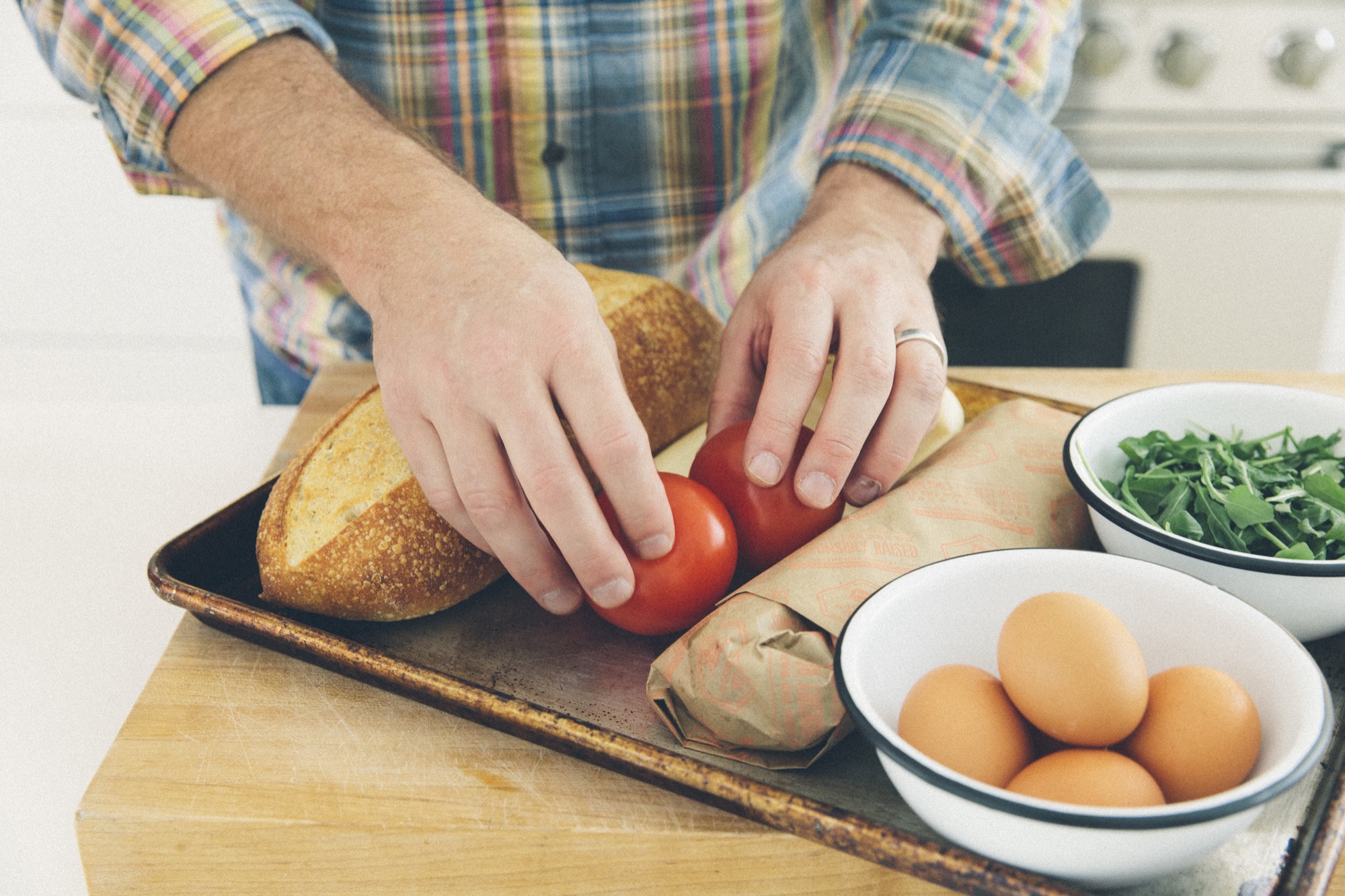
Kitchen memoirs
Each time I did have the courage to expose myself to something new, the experience had a profound impact on who I am today. At the time, it’s hard to know this. So you need to find courage to be out of your comfort zone.
When I was in college, I took a big risk plunging into a new experience. My father invited me to spend the summer with him and his wife on Block Island, Rhode Island. I had visited the island many times and loved it, but had never lived there, nor had I lived with my dad in quite some time. I was apprehensive. It was unfamiliar territory.
My father and his wife, Cynthia, live a life filled with the simple pleasures of food, wine, art, and entertaining—he, ever the consummate host, and she, chef extraordinaire. Thanks to his encyclopedic knowledge of wine, Dad has an interesting story to pair with whatever is in your glass, making every sip taste that much better. And Cynthia’s cooking is so effortless, the first bite makes you wonder how long it took her to make this food.
Life was relaxing at their comfortable house on a quiet dirt road. The sound of the crashing surf, trails to the beach or to town right out the back door. The bountiful garden grew every imaginable vegetable. When I close my eyes, I can still see the delicate squash, the bright green asparagus, the leafy arugula. It was an idyllic spot. A nostalgic place and a sense of life I wish I could revisit every year.
During that summer, I was exposed to something that has since become a defining part of who I am: good food. Cynthia subtly shared her love for food with me. She didn’t ask me to cook or to work in the garden or even to clean up the kitchen. Instead, she made delicious, satisfying food for me. All of the time. Each meal had ingredients from the garden, contributing to the fresh, delicious flavors. I don’t remember her actually showing me how to make any of it. I observed and asked questions. It was obvious she loved to cook. It was during that summer she instilled that same passion in me. I just didn’t know it yet.
"It was obvious she loved to cook. It was during that summer she instilled that same passion in me. I just didn’t know it yet."
The gifted Griswold
When I left the island to go back to school, Cynthia gave me a cast-iron pan. A Griswold #2, actually. I couldn’t have imagined then that a small pan would one day become such an essential part of my everyday life. When I dug out the Griswold years later, I realized the gift’s significance. It wasn’t just an amazing antique pan that’s incredibly hard to find nowadays, it was a gift that carried with it my love of food.
For the past fifteen years, I’ve been cooking all sorts of things—exploring different techniques, different combinations, growing my own vegetables, hosting dinner parties, challenging friends to cook-offs. I scour the latest cookbooks and food magazines for inspiration on what to make next. Cooking has become my passion, a gift that now I love to share with friends and family.
My favorite dish Cynthia would prepare in her cast-iron pan was an egg sandwich. I’m sharing how to make this sandwich with the hope it will push you, too, to try something new or bring back memories of a forgotten experience that may have made you who you are today. So here’s to summer. A time when the sun rises earlier, giving you extra time to sit, enjoy a tasty breakfast sandwich, and reflect. A time of renewal. A time to try new things. A process worth repeating over and over again. The reward is life-changing.
In Memoriam
I wrote this essay, which originally appeared in print in Alpine Modern 02, to honor my father and his wife, Cynthia. In the months since then, sadly, Cynthia has passed away. But I am enormously thankful she was able to enjoy this story—her story—and learn how much of an impact she had on me and my family. We love you, Cynthia.
Recipe: The Perfect Egg Sandwich
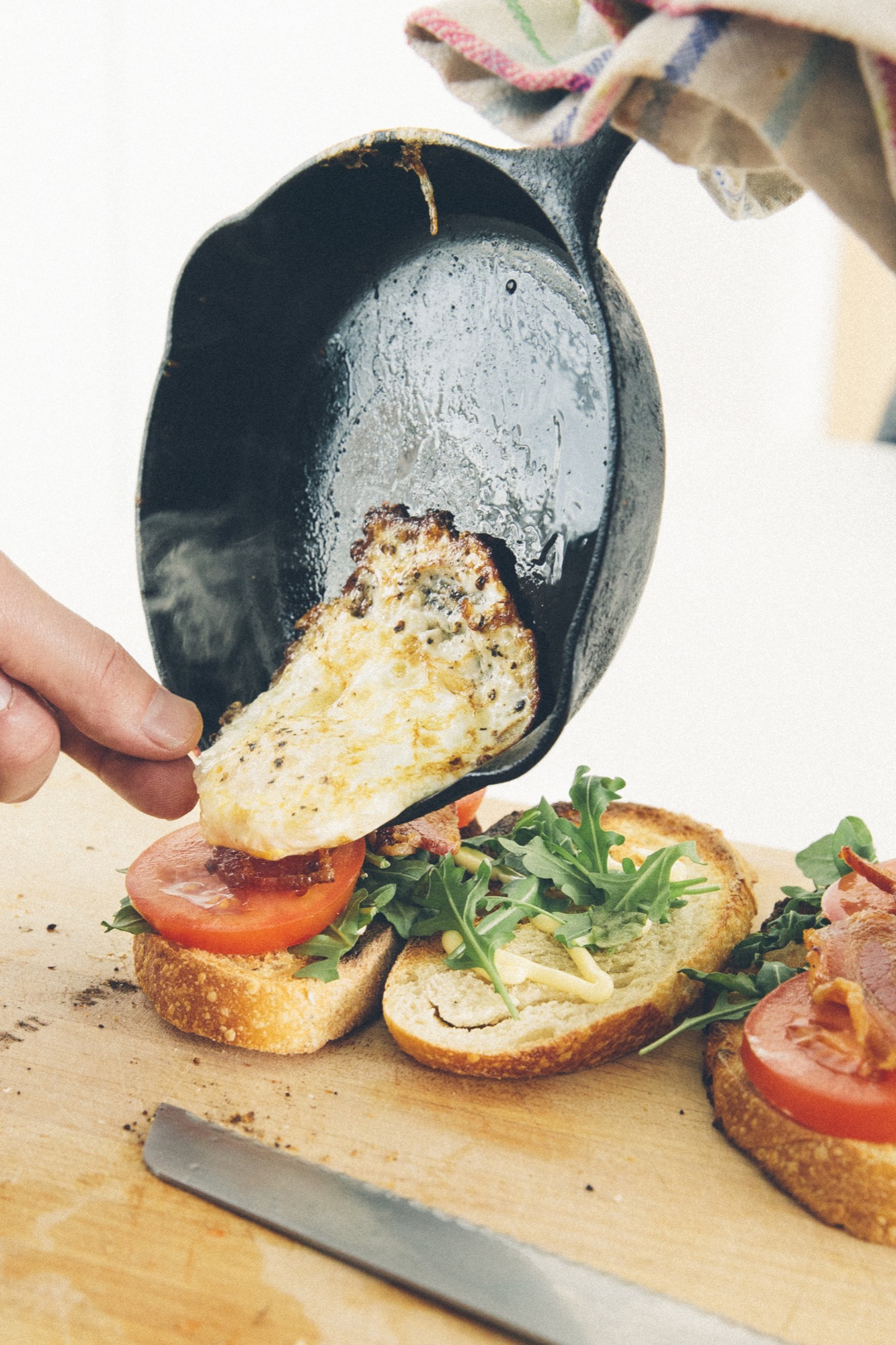
You need a small cast-iron pan...

How to season a cast-iron pan
- Wash your pan in hot soapy water to remove any surface oils. Then heat in a 200oF (ca. 90oC) oven until completely dry. The heat will also “open up” the iron, making it more accepting of the seasoning.
- Apply a thin coat of flaxseed oil to the hot pan. Coat it entirely. You’ll want to use an oven mitt since the pan will be hot.
- Wipe away all of the remaining oil. There will still be a very thin coat on the pan, but it should not appear oily. Using too much oil will result in streaks and a sticky surface.
- Bake the pan upside down in a 500º F (ca. 260º C) oven for 30 minutes. Then shut the oven o and let the pan cool inside. Heating the oil will cause it to create polymer chains, making for a dark, smooth surface.
- Repeat this seasoning process at least three times before cooking in a brand-new pan. The seasoning will continue to build as you use the pan, becoming darker and increasingly nonstick. The pan will also be easier to clean as the seasoning layers build.
Room for Gemütlichkeit
The "Stube" — a special place in the alpine homes of Bavaria and Austria
In the Bavarian and Austrian Alps, a Stube is a gathering place to slow down for sustenance and storytelling. In the German-speaking mountain regions, the Stube has traditionally been and still is today the heart of an alpine home. The parlor. It’s where the family eats, socializes, solves problems, celebrates birthdays, raises children, laughs, and cries together. In this room, “family” in truth can morph into any iteration bonded by a chosen connectedness that trumps blood and wedding bands. Neighbors playing cards on a dark winter’s night. A knitting circle looping yarn in silence. A clique of youngsters bantering at one friend’s house before a night out around the village.
“The table is a meeting place, a gathering ground, the source of sustenance and nourishment, festivity, safety, and satisfaction. A person cooking is a person giving: Even the simplest food is a gift.”
— Laurie Colwin

The Stube typically has a large wooden table to gather around—such as this sublimely simple exemplar by Fraai Berlin—and a woodstove. The traditional seating setup is an L-shaped wooden bench built into the focal corner of the Stube. If the family celebrates the region’s inveterate traditions and customs of the prevalent Catholic religion, a carved Jesus Christ looks down over that table from his wooden cross high up in the nook the locals call Herrgottswinkel—God’s corner.
A namesake style of alpine folklore—sylvan songs accompanied often by zither and guitar—fills the Stube... Stubenmusik. △
Recipe: The Alpine Glissade
A deliciously bittersweet cold-drip coffee cocktail
Ingredients
Serves two
- 1.5 oz (45 ml) Alpine Modern Cafe cold-drip coffee
- 0.5 oz (15 ml) filtered water
- 0.75 oz (22 ml) Bonal Gentiane Quina
- 0.25 oz (8 ml) Campari
- 0.25 oz (8 ml) Licor 43

Directions
Combine ingredients and pour over ice.
Quick stir in glass.
Garnish with orange peel.
Paradiesli
The other Swissness
As so often, my cameras were calling, and I had to go. I am lucky to have friends who, when not working, gladly accompany me on my excursions. “Let’s explore,” is my call to discovery. We usually end up in the mountains, hiking.
"My cameras were calling, and I had to go."
Up here, people’s individuality and way of life are more distinct and unseen than in the city. Ski-lift stations, military bunkers, snow fences, cabins, trailer parks . . . all these structures must conform to the mountain, thus take on a distinct form, often innately optimal. Set amidst glorious nature.
I was on the road with my friend Pascal Alexander that day. We eventually arrived in Flumserberg. It was fall. Everything seemed deserted; too chilly for hikers — ski season weeks away.
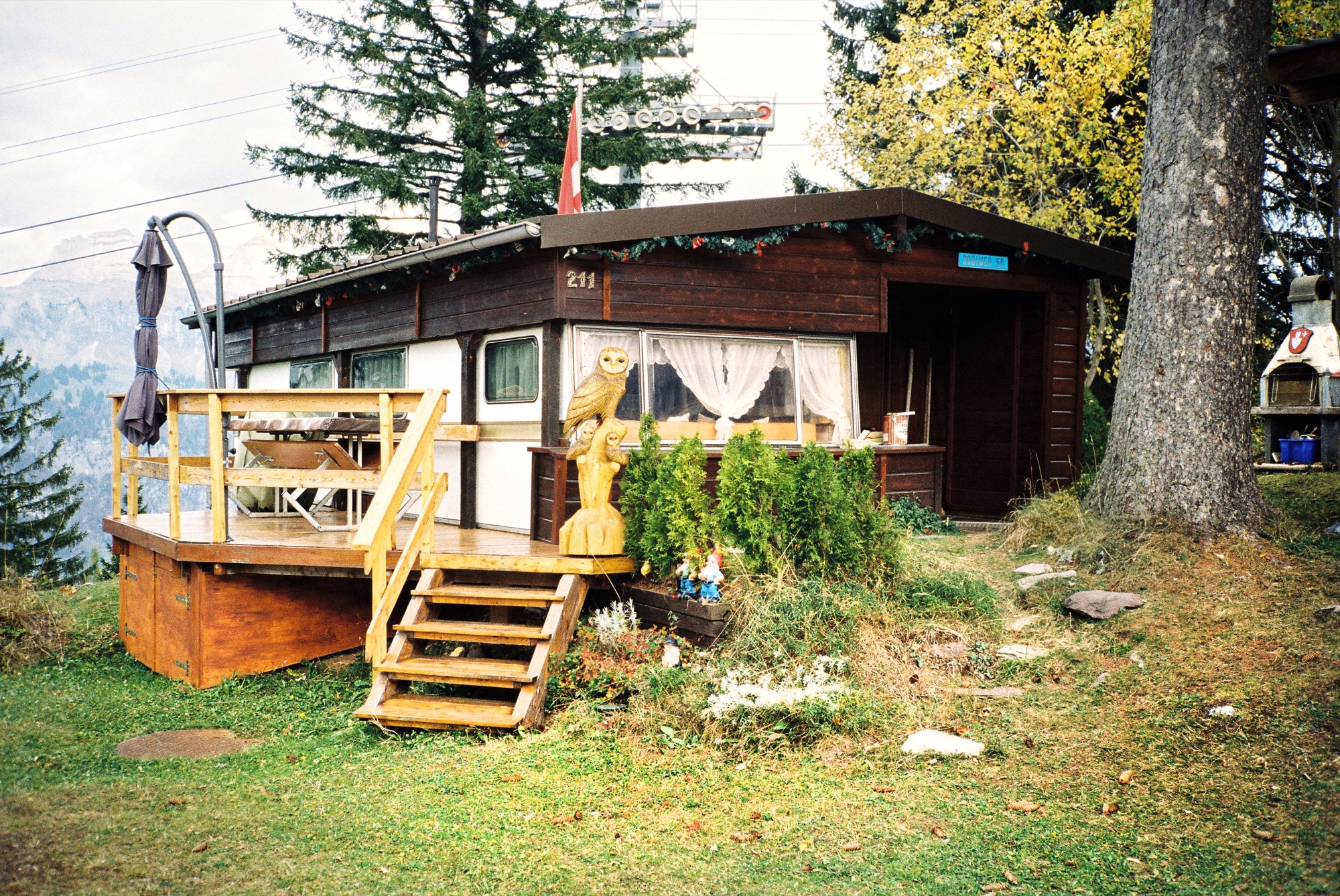
Wondrously weird
Past the first ski-lift station, we stumbled on a small settlement of what appeared to be a cluster of tiny houses, built closely together. But as we approached, we realized they were trailers, some of them encased in wood. The inhabitants had added roofs, porches, sunrooms, and other elements of a permanent home. A wondrously weird place. A mix of mobile and xed installations. We had never seen anything like it. Fascinating how humankind had once more found a way to settle, in their individual ways, with such adoration for detail.
"Fascinating how humankind had once more found a way to settle, in their individual ways, with such adoration for detail."
Walking up the hill, we came upon more trailers dotting the landscape. Because of the steep slope, the trailers needed to be raised up on scantlings, rocks, and boards to sit leveled.
The site didn’t look like a place one would (or could) haul a heavy vehicle up to. The trailers just stood there in the middle of the landscape. We strolled between the installations, not encountering a soul.
"The trailers just stood there in the middle of the landscape."
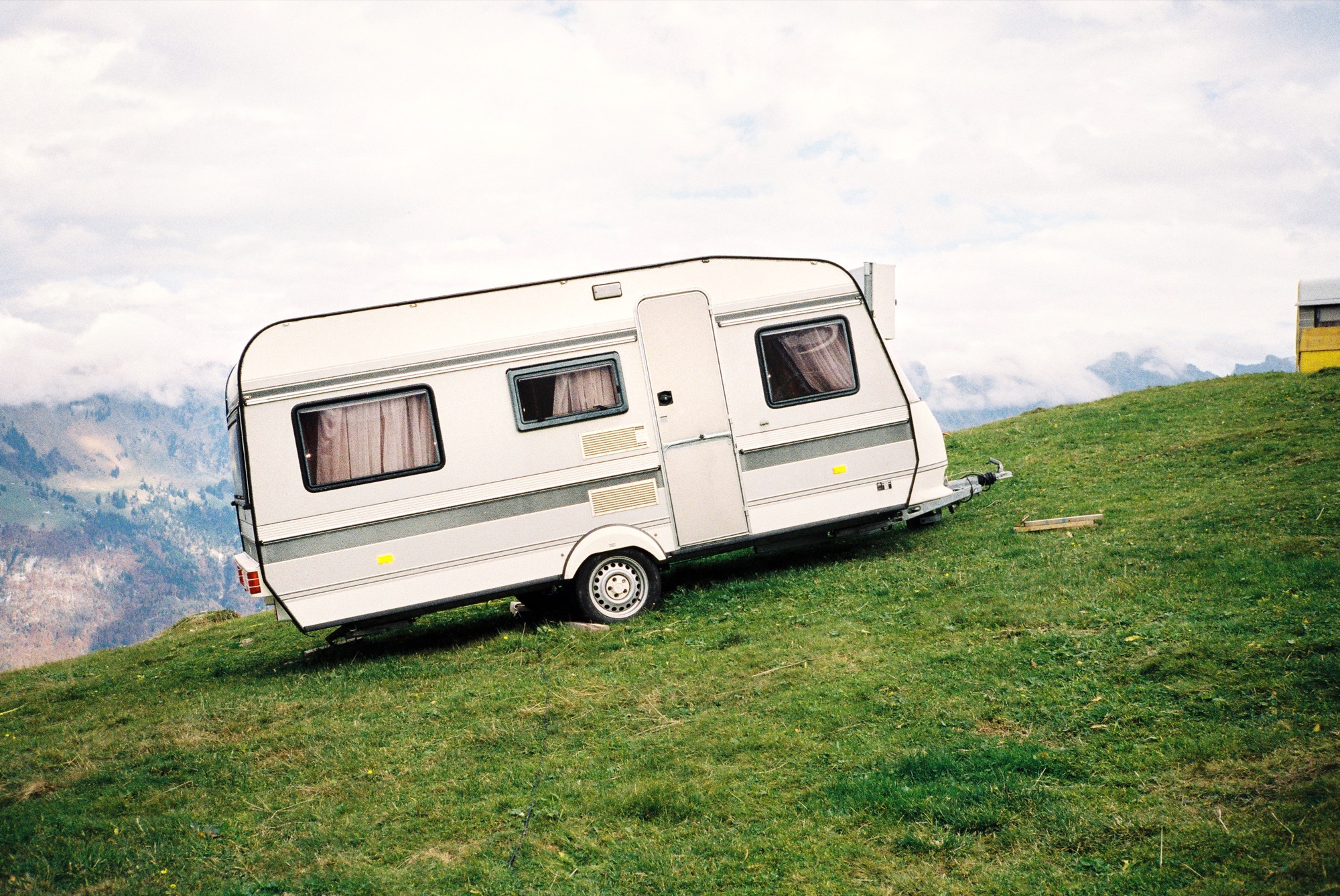
Un-Swiss
Trailer parks are not a Swiss thing. The whole setting felt surreal; eerie yet peaceful. They call it “Paradiesli” — small paradise. An unpretentious place of freedom and independence, with breathtaking views of the Churfirsten, one of Switzerland’s most impressive mountain ranges. △
"An unpretentious place of freedom and independence."
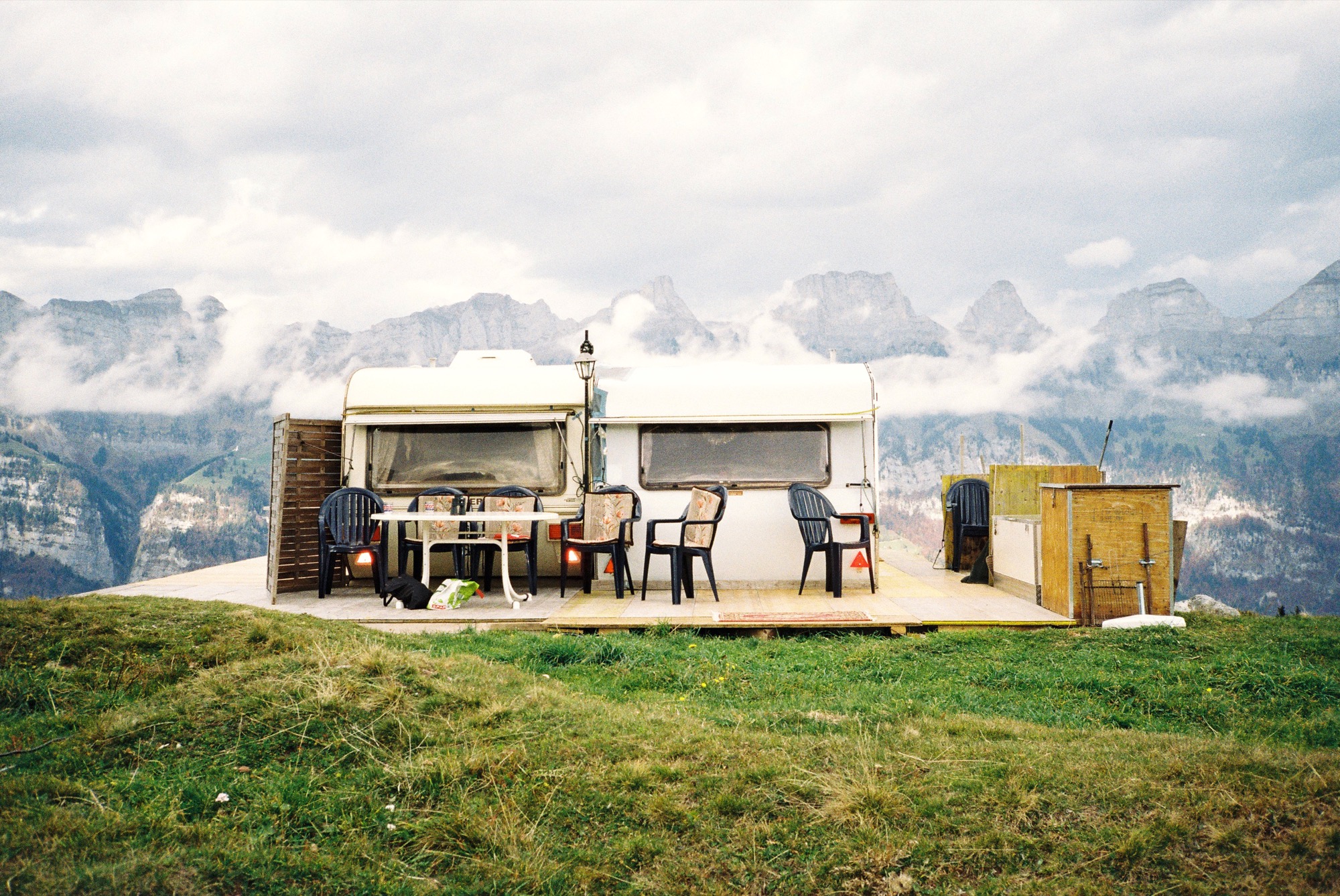
Repair With Gold
The Japanese tradition of wabi-sabi
The Japanese savoir vivre has a name, yet is almost impossible to define. What does it feel like? Does it live in old objects or is it intangible? Wabi-sabi is the mindful balance between treasuring simply beautiful things and relishing freedom from things. When a piece of pottery breaks in Japan, the traditional practice is to fuse the pieces back together with gold lacquer. The Japanese word for this practice—kintsukuroi—doesn’t just refer to the method of repair, it also suggests that the tea bowl is more beautiful because of the crack. The gold is a bright line of the pottery’s imperfection. In the West, we tend to judge a repair by whether it is noticeable—the less evidence of a rip, scratch, or stain, the better. The traditional Japanese practice is the opposite. In a Japanese tea ceremony, guests are served with the most cracked and different side of the tea bowl facing toward them. The imperfections are emphasized and appreciated.
The sense that imperfection makes the tea bowl more beautiful, or at least more interesting, is known as “wabi-sabi.” Wabi-sabi is very difficult to define. Considered by many to be the aesthetic of Japan, it is a know-it-when-you-see-it kind of thing. And like most aesthetics, wabi-sabi is about more than how things look. It suggests a way to live.
“Things wabi-sabi are appreciated only during direct contact and use; they are never locked away in a museum. Things wabi-sabi have no need for the reassurance of status or the validation of market culture.” — Leonard Koren, author of Wabi-Sabi for Artists, Designers, Poets, and Philosophers
I missed breakfast the morning of my first tea ceremony. Only four months into my stay in Japan, I had not yet adjusted to the Japanese concept of time. When my friend said she’d pick me up at seven, she meant six forty-five: a fifteen-minute sign of respect.
My stomach growled as we drove along the Sai River toward downtown Kanazawa. Japan’s famous cherry blossoms had just reached this small city nestled between the Japanese Alps and the Sea of Japan, on their bloom north from Okinawa to Hokkaido.
To celebrate the season, the small treats, wagashi, served with tea at our ceremony that morning were pink cherry-blossom-flavored macaroonesque pastries. Unfortunately for my empty stomach, we were each given a single, tiny wagashi before our tea was served. Everyone fell silent as they focused fully on eating their treat. A tea ceremony is a cross between performance art and meditation. Each action is intentional and slow; it is a kind of spiritual exercise. The simple act of making and then drinking tea is elevated through total attention to the people and objects involved.
Once we finished our wagashi, an elderly tea master served us ceramic tea bowls full of frothy matcha that required two hands to hold. Splotches of green and black interspersed with faint gold lines covered the surface of each bowl. The rim was uneven, and small nicks lined the bottom. The tea master showed us how to examine our bowl before our first sip. This amounted to a lesson in applied wabi-sabi. We paused to find and create beauty from the simple, humble, and nonobvious—the cracks in our ceramic tea bowls. Cultivating a wabi-sabi mindset requires overriding our default responses to what qualifies as beautiful and what qualifies as ugly, what is worth paying attention to, and what is not. A tea ceremony is one way to practice this, and it is equally important (and useful) in day-to-day life.
Transforming the ordinary
For me, the most important moment of the morning happened once the tea ceremony concluded. We were directed into a drafty back room and told to wait there for lunch. A few minutes later, a teenage boy showed up and placed a stack of seven bento boxes on a table near the door. We passed the boxes around and then began to eat, still wearing the kimonos we had put on for the ceremony, seated atop overturned foam seafood crates.
One of the many sections of the bento box held kaki no ha zushi, a specialty of Kanazawa’s prefecture. Kaki no ha zushi is a square of rice topped with thin slices of fish or vegetables and then wrapped in a persimmon leaf. I eagerly tore open my leaf as I would the paper wrapping of a burger, ready to finally fill my stomach. Seated right beside me was a sixteen-year-old girl named Sui who had taken me under her wing during the ceremony. When one of the tea masters said something my limited Japanese could not decode, she would discreetly slip her iPhone from the sleeve of her kimono and type into a translator. “When you have to stir the tea, more calm”... “Bow before the step back”... I read on a screen the girl shyly turned towards me.
Sui eyed the crumpled leaf of my kaki no ha zushi with concern. Then she reached over, took it from my hands, and folded the leaf neatly around the rice, gently smoothing each corner down with her fingertips so that it matched her own. She handed it back to me, and I felt moved.
Feelings and folding
“It’s a feeling.” That’s as close as I have come to a definition of wabi-sabi from a Japanese person. It came from a thirty-something man named Kei, whom I worked beside as a line cook in a kitchen in Niseko. At the time, I had just been trying to make conversation while we chopped daikon. I didn’t know quite what he meant. “It’s a feeling.”
But months after Kei’s definition, and weeks after the tea ceremony, I kept thinking about Sui’s simple action: folding my leaf. And each time I did, I felt a particular way. I started to understand what Kei meant when he told me that wabi-sabi is a feeling.
It’s the feeling you get when you look at an old kitchen table, not the feeling you get when you look at pristine china in a cabinet. It’s a strange mix of nostalgia for an object’s past and gratitude for its present functionality—and something else, harder to define. It’s the feeling you get when you see a dead flower, or the last traces of a sunset. It is a recognition of the cycles of life and death, use and disuse. It is the feeling you get when you see the natural world reflected in material objects—a rusty patch of metal, a worn piece of wood. Asymmetry is the toll the elements take.
"Asymmetry is the toll the elements take."
Wabi-sabi is looking at the imperfections of the world and transforming them into a kind of beauty—not by changing them, but by changing how we relate to them. Instead of trying to get away from boredom, endings, and loneliness, the feeling of wabi-sabi is what happens when you work to make those things beautiful. It is the philosophical analog of the gold line to emphasize the pottery’s crack.
The leaf that Sui folded for me was nothing if not impermanent—I’d be throwing it away in mere minutes. It was an everyday object—just a little leaf around my lunch. And nothing about our surroundings suggested that the lunch was important—we were in a tiny little room, not even sitting at real tables. But Sui slowed me down, she recognized that the leaf and moment, while imperfect, were still a site of possible beauty. She was not trying to make a point. The ceremony was over. She was just living. And that is what wabi-sabi is: the beauty of the everyday, the small, the inconspicuous. The beauty of life as it is lived.△
Go Wild
Wilderness to table: Serve what nature offers where you are
Forage the forest floor, fish the mountain creek, and relearn respect for nature’s abundant gift of authentic ingredients. Following in the footsteps of culinary ground-breakers like Chef René Redzepi (Noma, Copenhagen, Denmark) and Chef Magnus Nilsson (Fäviken, Åre, Sweden), Alpine Modern wanders into the woods . . . where the wild things are.
The wilderness-to-table movement is the antithesis of getting any product from anywhere in the world anytime, in season or not. Hunting and gathering for your meal du jour takes advantage of what grows or lives in the place where you are, at the time an ingredient is ripe and ready. The food you eat is your connection to the present and to where you are in the world.
"The food you eat is your connection to the present and to where you are in the world."
Elevated Localism
Foraged food takes the concept of eating local yet further. All around the world, entire restaurants are now based on the principle of serving what nature offers right outside the door — the menu written by place and time. Chef René Redzepi at restaurant Noma in Copenhagen, Denmark, is conceivably the progenitor of a culinary counterculture that looks to the local landscape to rediscover an innately authentic fine cuisine, made from what is.
Seasons once again have significance. So, what to serve during the winter months, if FedExing in- gredients from halfway around the world conflicts with your food philosophy? Our ancestors’ preser- vation methods—pickling, jarring, canning, curing, kippering—have dwindled to all but forgotten skills. Magnus Nilsson, head chef of Fäviken Magasinet restaurant in Northern Sweden and au- thor of the complementing cookbook Fäviken, is a master curator of these past techniques, carefully maintaining the traditions like a dying language.
"Seasons once again have significance."
A Dish, Discovered
Recipes and shopping lists are needless in foraging for nature’s edible glory, since searching the forest for a particular wild vegetable could prove a foolish attempt. Look around instead, mind wide open. Awareness comes before inspiration.
"Recipes and shopping lists are needless in foraging for nature’s edible glory, since searching the forest for a particular wild vegetable could prove a foolish attempt."
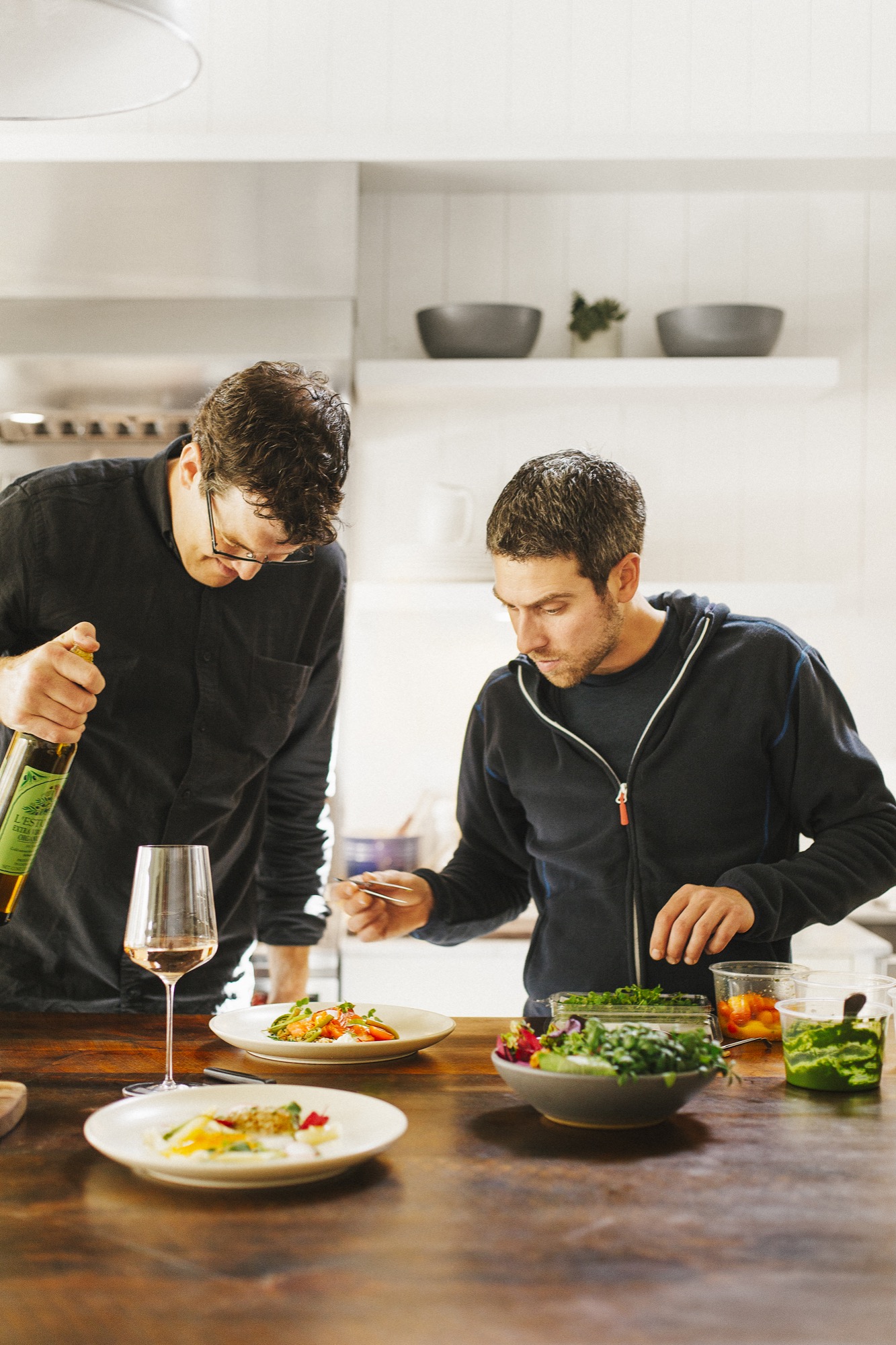
Granted, rambling meadows, curious what you may cook, can be daunting, whether you’re expecting friends over or feeding your über-exclusive restaurant’s patrons. The unknown, the serendipity, the exploratory idea of discovering, aha, it’s porcini for dinner, become part of the adventure. What’s more, wild ingredients will vary widely, and you may not find perfect bunches of white asparagus under a spruce tree. Nevertheless, anytime you pull an ingredient out of the ground or catch it from the creek, you are going to respect its more distinct, more identifiable flavor the more for it.
Alpine Modern’s resident culinary mastermind, Colin Kirby (El Bulli, Spain, 2008), knows to step out of the way of fresh, pure ingredients. If life deals him morels, he lets them shine by applying minimal technique.
Here, the mindful chef curates a spread of dishes and drinks that taste of the here and now. Go wild with him. △
Wilderness-to-table recipes
White Asparagus and Morel Salad
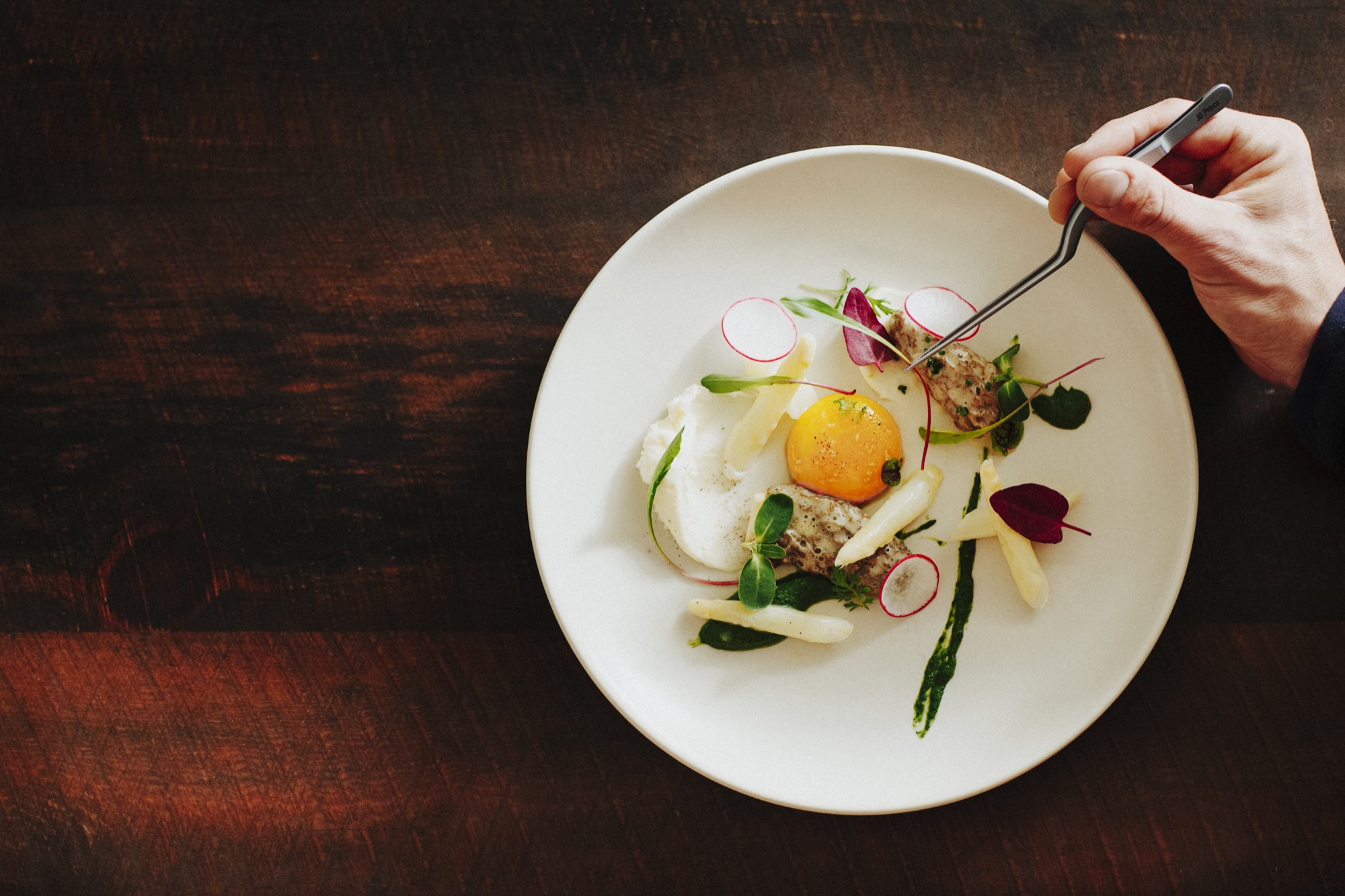
A delicate side dish with morels poached in beurre monte, asparagus and egg on ramp top puree. Recipe »
Smoked Trout Salad
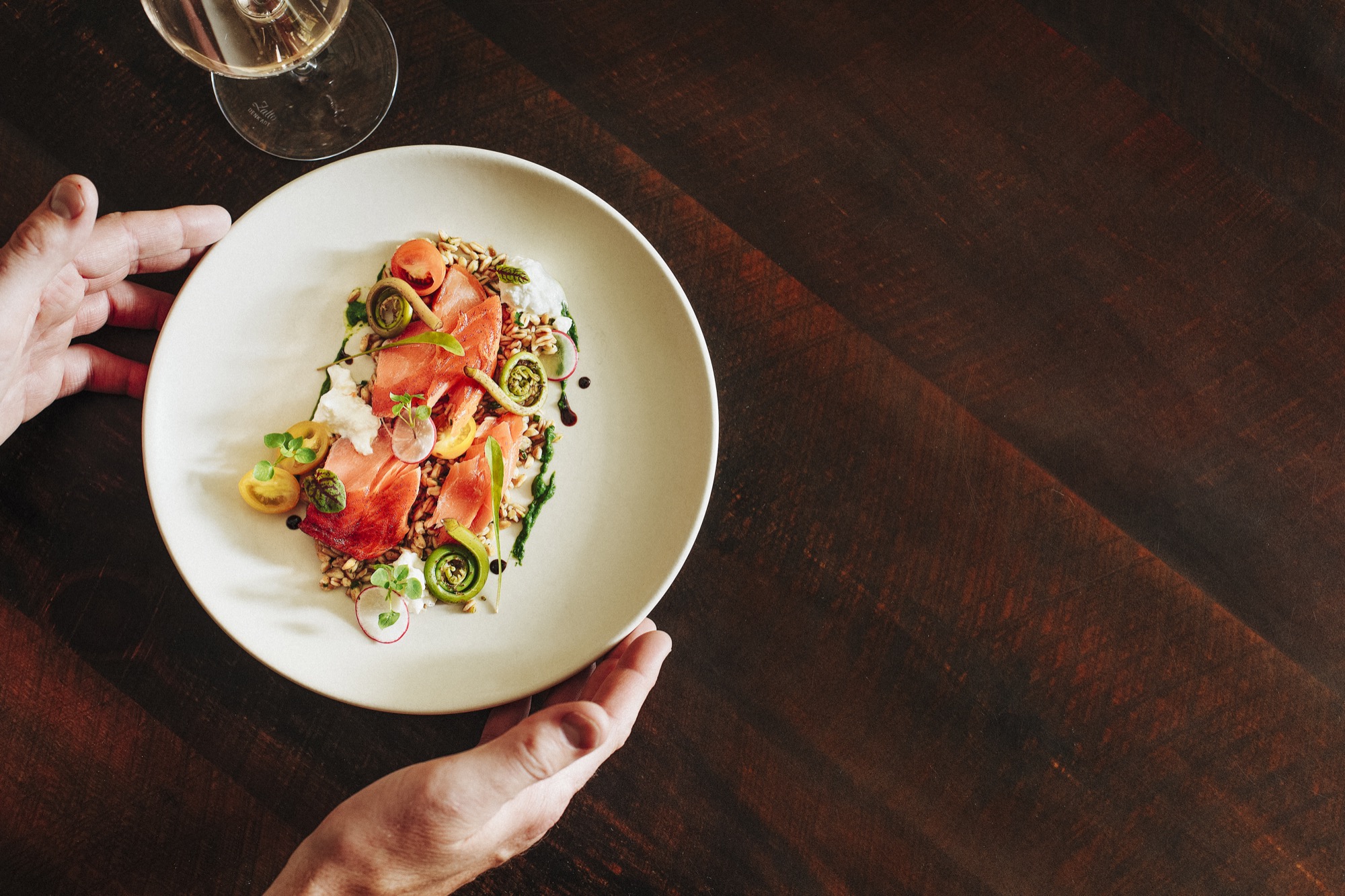
A wild and fresh dish with your smoked catch and fiddlehead ferns with its great woodsy, almost bitter flavor reminiscent of the forest floor. Recipe »
Alpine Fizz
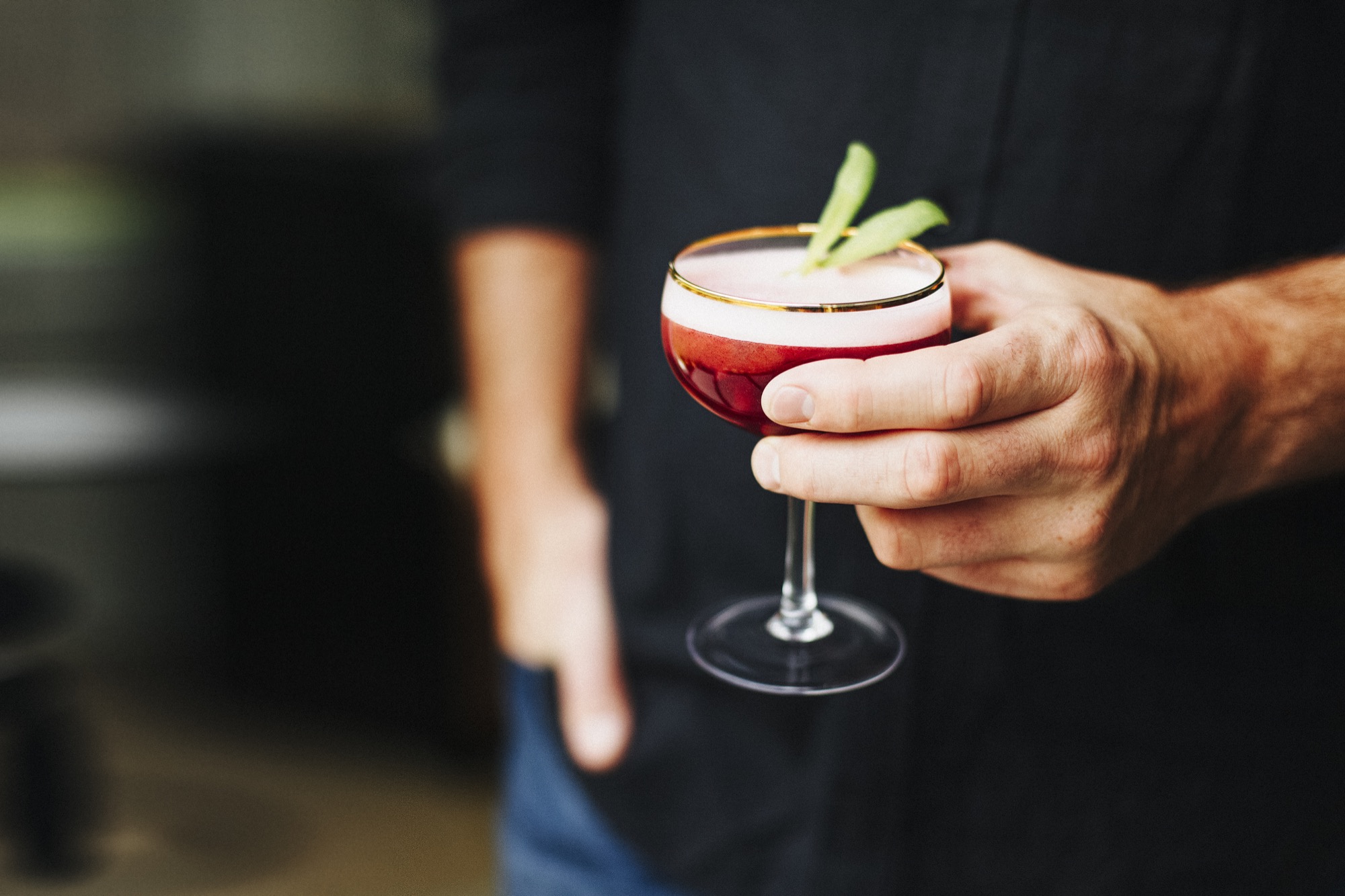
A fizzy gin cocktail with homemade huckleberry-sage syrup. Recipe »
Recipe: White Asparagus and Morel Salad
A delicate side dish with morels poached in beurre monte
Ingredients
- 6 white asparagus
- 6 morels (cleaned)
- 2 radishes
- 1 bunch ramp tops
- 1 egg yolk
- 1 shallot
- 2 pounds (907 grams) butter (cubed)
- 1 tablespoon (15 milliliters) water (for beurre monte)
- 4 ounces (113.3 grams) Delice de Bourgogne cheese
- Dandelion greens
- Sheep sorrel
- Red orach
- Purslane
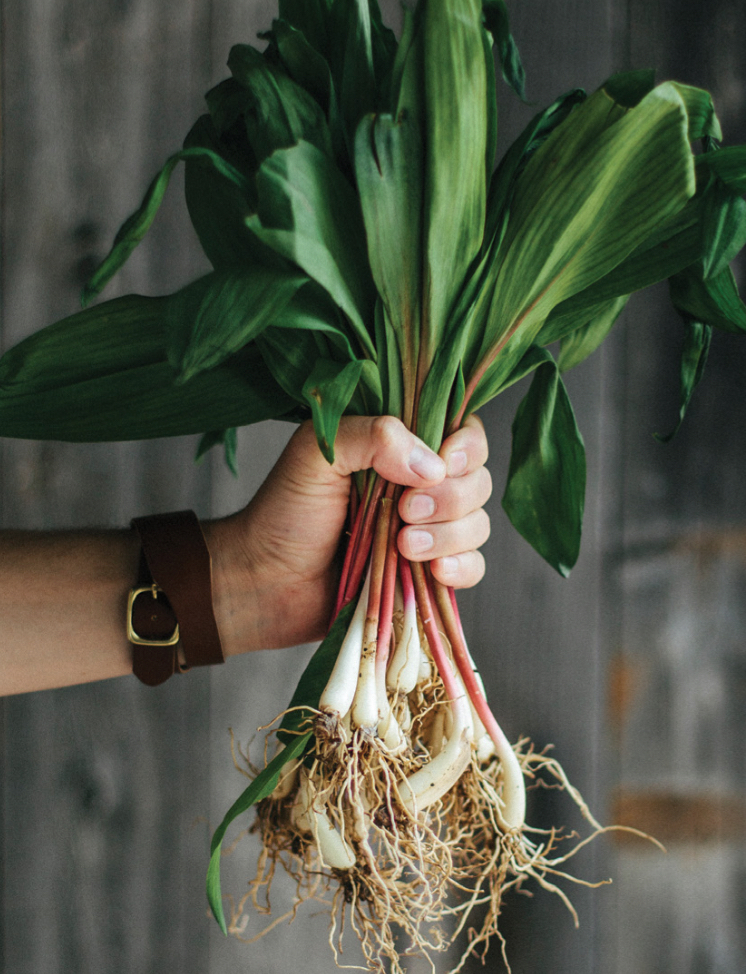
For the white asparagus
Trim away the woody ends and blanch the white asparagus in salted boiling water until cooked (three minutes). Transfer to an ice bath. Once cool, cut each piece into three small pieces (batons). Reserve for later.
For the ramp top puree
In a saute pan, add the diced shallot and one tablespoon (15 grams) of butter to hot pan. Sauté shallot until translucent. Add cleaned ramp tops and cook for five to seven minutes. Add cooked mixture to blender and puree on high for thirty seconds. Chill and reserve.
For the beurre monte
Add one tablespoon (15 milliliters) of water to saucier pot, heat, and slowly add the cubed butter. Whisk constantly until water and butter have emulsified. Season generously with salt and pepper. Reserve on a simmer.
For the egg yolk
Cook for one hour at 63.5º C (146º F) in a mixture of grapeseed and olive oil.
To Finish
Gently poach the cleaned morels in the beurre monte mixture for four
minutes. Wipe off any excess butter. Put on the plate.
Toss the white asparagus in a small amount of the warm beurre monte, and put on the plate.
Spoon the ramp top puree alongside the morels and white asparagus.
Place the Delice De Bourgogne on the plate.
Add warm egg yolk, sliced radish, dandelion greens, red orach, and purslane.
Recipe: Alpine Fizz
A gin cocktail with homemade huckleberry-sage syrup
Ingredients
- 1½ ounces (44 milliliters) CapRock Gin
- ½ ounce (15 milliliters) Braulio
- ½ ounce (15 milliliters) huckleberry-sage syrup *(see additional recipe)
- ¾ ounce (22 milliliters) lemon juice
- 1 egg white
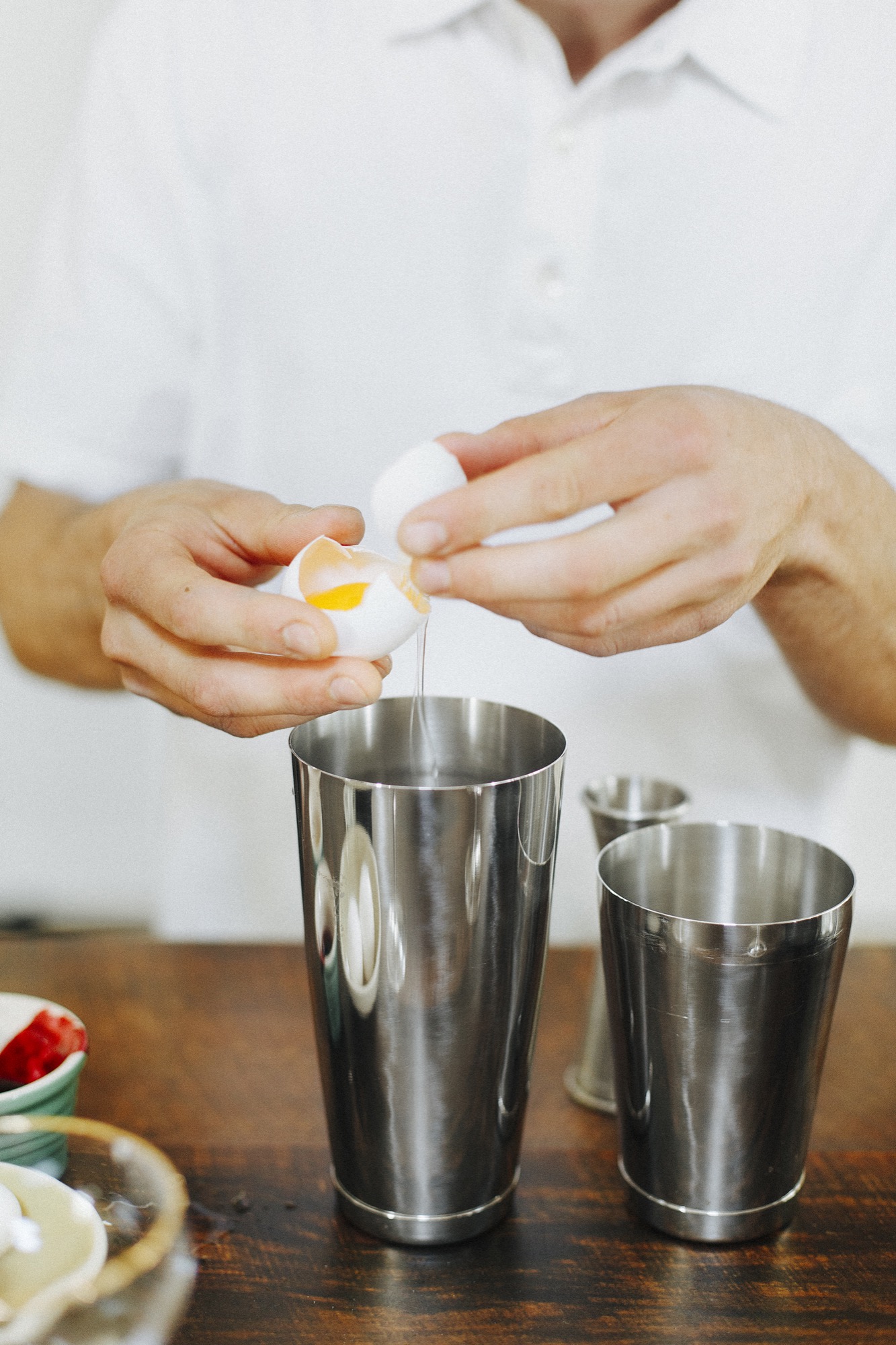
Combine all ingredients in a shaker tin.
Dry shake ingredients without ice to aerate egg white.
Shake ingredients with ice to chill and dilute.
Using a hawthorne and a ne strainer, strain cocktail into a chilled coupe.
Garnish with fresh herbs and/or huckleberries.
For the huckleberry-sage syrup
Combine equal parts huckleberries and granulated sugar into a sauce pot.
Bring to a boil and simmer just until the huckleberries begin to burst.
Add sage leaves and continue to simmer gently.
Once infused, remove sage leaves and discard.
Place syrup into a blender and blend until smooth.
Strain syrup with a strainer and refrigerate until cool.
Final product should be thick but pourable, adjust with water if necessary.
Recipe: Smoked Trout Salad
Home-smoked fish alongside woodsy fiddlehead ferns
Ingredients
- 1 cup (236.5 grams) salt
- ⅓ cup (71 grams) sugar
- 8 ounces (227 grams) emmer wheat (farro)
- 1 lemon
- 1 bunch parsley
- Fresh cherry tomatoes
- Chives
- Sherry vinegar
- 8 fiddlehead ferns
- 6 ounces (170 grams) fresh cheese (burrata)
- Dandelion greens
- Chickweed
- Red ribbon sorrel
- Wild wood sorrel
- Yarrow
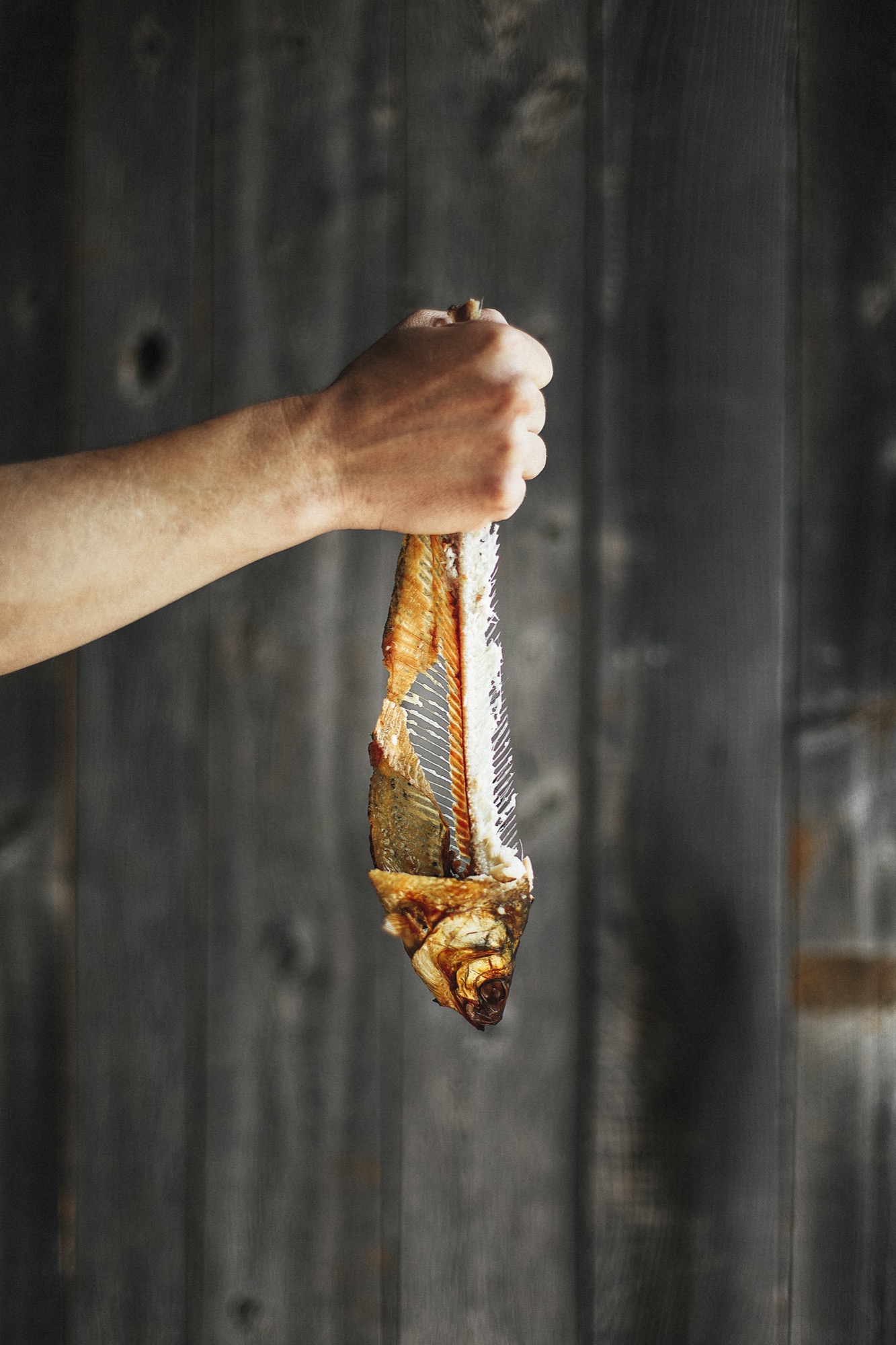
For the smoked trout
Combine one cup salt (236.5 grams) and one-third cup (71 grams) sugar and sprinkle evenly over the small filleted fish. Refrigerate for eight hours to cure. Remove from fridge and rinse under cold water. Refrigerate the fish overnight, uncovered. In the morning, light the charcoal grill (preferably using applewood and charcoal). Once the coals are hot, push them to one side of the grill. Place a tray with ice next to the coals. Put the grill grate on top of the charcoal and the tray of ice. Set the trout on a metal baking pan directly above the tray of ice and “smoke” the trout for ten minutes.
For the farro
Put the farro in a pot and fill with cold, salted water until the farro is submerged. Bring to a boil and simmer. Cook for fifteen minutes until the farro is tender. Strain. Season generously with lemon juice, sherry vinegar, salt, and pepper. Add sliced tomatoes, sliced chives, and parsley.
For the fiddlehead ferns
Remove the top portion of the stems and blanch in a large pot of salted, boiling water for a eight to ten minutes, until tender. Place in a small ice bath to stop the cooking process.
To finish
Spoon the nished farro onto the plate.
Add the smoked trout on top.
Garnish by adding the fresh farm cheese, seasoned fiddlehead ferns, dandelion greens, chickweed, sorrels, and yarrow.
Drizzle with Extra Virgin Olive Oil.
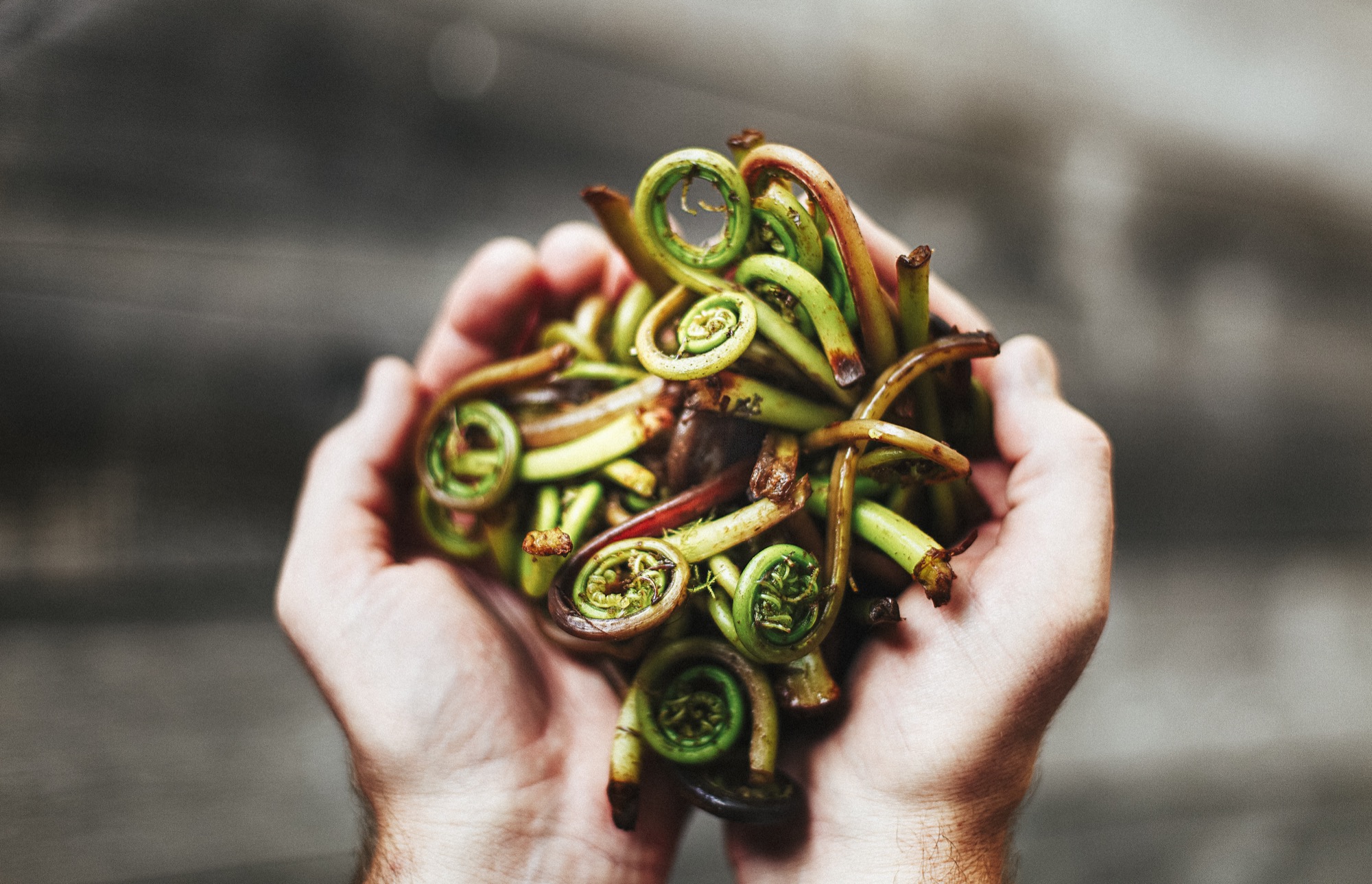
Alpine Modern Chef Colin Kirby on fiddlehead ferns:
The ingredients featured in these pages make all the difference. Wild, fresh, and foraged flavors have become a staple in the culinary world, and this dish reflects that point. A main component to the smoked trout dish is the fiddlehead fern. The ferns have a great woodsy, almost bitter flavor reminiscent of where they came from: the forest floor. Their texture is superb, providing an added bite to the creaminess of the trout and fresh cheese. Technically, they are the furled fronds of ferns. They are incredibly healthful as well, high in fatty acids. Fiddlehead ferns can also be pickled and eaten anytime.
The Taste of Extreme Altitude
Chef Virgilio Martínez-Vélez of Central Restaurante in Lima, Peru, harvests his rare ingredients high up in the Andes
Imagine a dish harvested only from the sparse pickings and rarified heights of 14,000 feet elevation. In Lima, Peru, Central Restaurante offers just that along with an ascending scale of dishes from the ocean's depths, amazonian jungle, and Andean peaks—each unique to a specific elevation and ecosystem. “When you go up the mountains, you find different species, people, cultures, and different thinking . . . about gastronomy, nature, whatever. You see the world in altitudes — and attitudes — and our perspective has to change. All these different climates and landscapes, geography, cultures, and people are driving a new way to see our landscape, our environment,” says Peruvian chef Virgilio Martínez-Véliz, who strives to present this panorama of altitudes and attitudes in his menus at Central Restaurante in Lima, Peru. Martínez sources Central’s menu from Peru’s coastal waters, Amazonian jungles, and Andean peaks using traditional indigenous ingredients to reflect his country’s rich cultural, culinary, and agricultural heritage. Peru’s ancient but highly advanced agricultural practices put it on the map as one of the cradles of civilization.
"When you go up the mountains, you find different species, people, cultures, and different thinking . . . about gastronomy, nature, whatever. You see the world in altitudes — and attitudes — and our perspective has to change."

For the third consecutive year, the Peruvian dining guide Summum has named Central the best restaurant in Peru, with additional awards for best contemporary Peruvian cuisine, best sommelier, and fourth-best restaurant in South America. In April 2013, Central entered as number fifty in The World’s 50 Best Restaurants, as awarded by the British magazine Restaurant. In 2014, Central jumped thirty-five places to number fifteen, winning the "Highest Climber" award, and later that year was named best restaurant in Latin America by Latin America’s 50 Best Restaurants. As of 2015, Central catapulted to the number four spot in The World’s 50 Best Restaurants.

Highest climber, indeed — Martínez’s signature carte du jour, Alturas Mater, or “Mater Elevations,” is an eighteen-course tasting menu with selections rising from Peru’s marine depths to its misty Andean heights, with specific elevations printed next to each item. Topping out on the list is Altura Extrema, or “Extreme Altitude,” sourced from a hypoxic 4,400 meters (14,436 feet).
Peak Ingredients
“It has three main ingredients,” says Martínez. “One is a potato called tocosh that grows only in that area. The people soaked it in the Andean rivers, which caused fermentation. It is very watery, rotten, and smelly, but it was a way to preserve the potatoes for the entire year,” Martínez says. “The next ingredient is cushuro, a cyanobacteria that grows in the high mountain lakes because of the atmosphere, the soil, the altitude, lack of oxygen, because of many, many factors. That ingredient is important. The third ingredient is the herbs that grow at that altitude,” he says. “There are not many herbs or fruits, but we are getting a few herbs from there as well. It’s a dish that’s our main focus on the one ecosystem, because that altitude is unique. That particular dish is very interesting.”

To create it, he says, “We first drain the potato for two days, because it’s actually very smelly. Then we dry the potato, cover it with three high-altitude aromatic herbs — muna, huacatay, and paico — and bake it. A crust forms with the stems of the herbs, and the smell is nice; they [the stems] have a meat aroma. We remove it from the oven, then we add a sauce made from the tree tomato, which grows in the Andes. Next, we cover the potato with the cushuro. The potato skins are also dried and then put on top just to cover. Finally, we add some herbs, and it’s finished. This is just one course in the eighteen-course tasting menu and one of two vegetarian dishes on our menu.”
The taste? There’s the meatlike aroma from the herbs, the tang of the tree-tomato sauce and the cushuro — the flavor of which is “just clean, delicate Andean water, with an herbed, delicate taste,” says Martínez. “The texture is the most amazing thing.” But at the heart of the dish is the special tocosh potato. “It’s the pure essence — the real history — of the Andean potato, that hasn’t been transformed into something else,” Martínez says. “Of course, because of the fermentation, the potato itself has a transformation,” he says, but it’s an authentic, ancient Andean potato from that high altitude, untouched by hybridization.

Peru gave the world the potato, which in turn influenced the course of civilization globally after the Spanish introduced it in Europe. The potato entered history around 7,000 years ago in the Titicaca Plateau, which stretches across today’s countries of Peru and Bolivia. At elevations up to 4,572 meters (15,000 feet), the Aymara Indians developed and cultivated more than 200 varieties of potatoes, which formed the main basis of the Aymara Indian and Incan diet.
Chef and Explorer
Martínez could be classified as a kind of geo-paleo-gastronomist. With his physician sister Malena, he founded Mater Iniciativa, a research institute to catalogue his culinary findings from his gastronomic explorations. The two, along with a group of researchers, including an anthropologist, forest engineer, and other chefs, travel to different elevations and ecosystems in Peru collecting and compiling the histories of traditional indigenous plants, herbs, and fruits — including such oddities as edible clay and tree bark, also on Central’s tasting menu. Then they catalogue it all in a database. For now the institute is based at Central, but will soon move to Cusco, the cultural and archeological capital of Peru — and in ancient times, of all South America. Martínez already travels to Cusco several times a month to go higher in the Andes for his research and culinary collecting.
Growing up in Lima with an architect mother and a bank-lawyer father, Martínez was exposed to Peru’s culture and melting-pot culinary scene. He was an avid skateboarder in the city streets and always had a love of cooking and exploring various cuisines, including Japanese, Italian and Chifa, the Chinese-Peruvian food fusion that has been a national craze and institution since Chinese immigrants arrived more than a century ago. Martínez tried law school for two years but left to travel, eventually landing a cooking job in Canada. After that he enrolled in Le Cordon Bleu in London and graduated in 1998. He then cooked his way through Europe, Southeast Asia, and New York, finally returning to Peru to helm Gastón Acurio’s acclaimed restaurant Astrid y Gastón. Finally, in 2010, he opened his own restaurant, Central. Central’s chef de cuisine is Pía León, Martínez’s wife. After the two worked together for two years, they married on May 4, 2013. In addition to Central, located in Lima’s trendy Miraflores District, a stone’s throw from the Pacific Ocean, thirty-seven-year-old Martínez operates two successful London restaurants — Lima and Lima Floral — and is about to open another in Lima, called Nos. All of them focus on traditional Peruvian dishes with contemporary approaches.
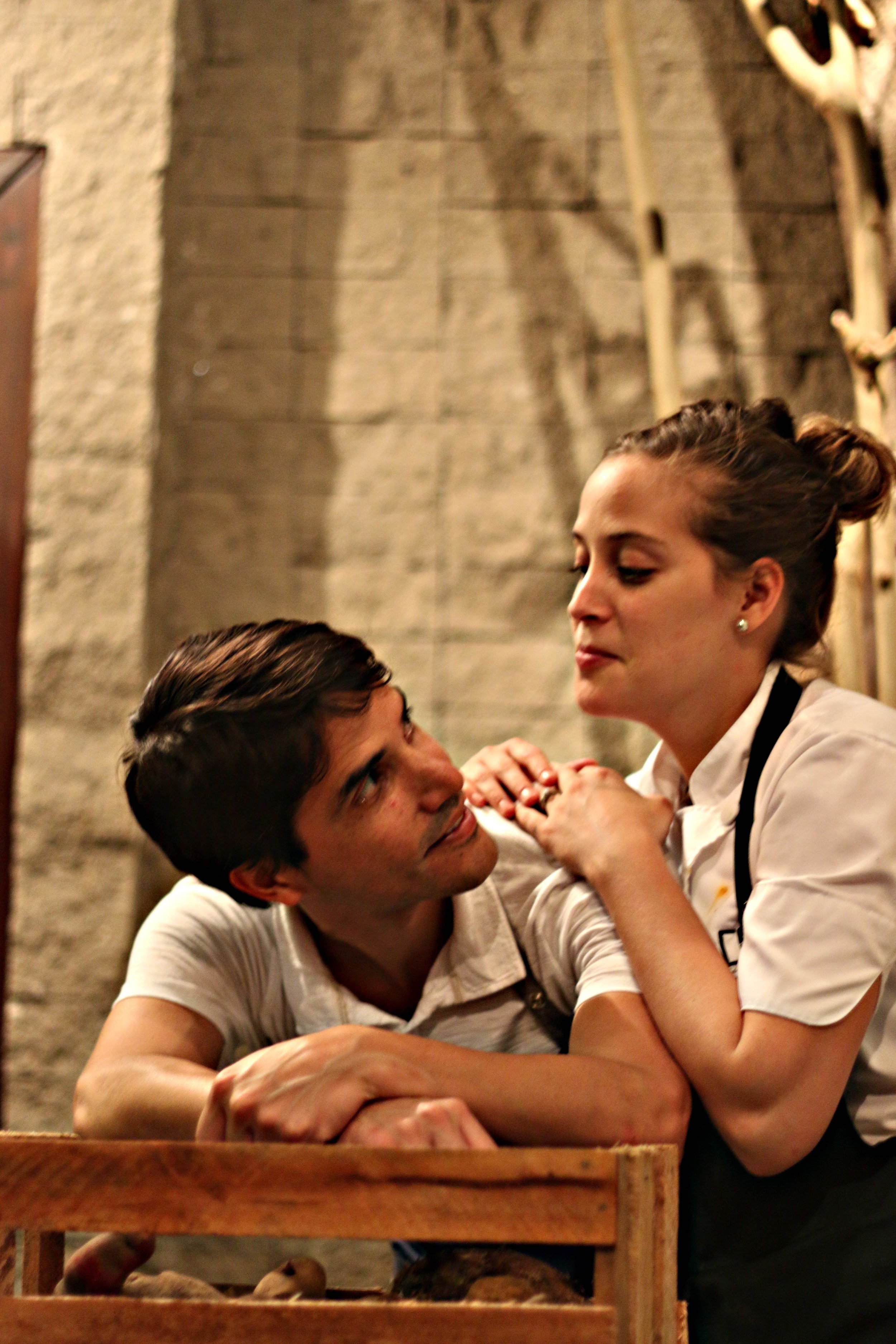
Beyond Cuisine
“It’s all about the sense of place,” Martínez describes his approach. “When you have a dish we really want you to feel what’s going on in that location, in that area. It’s a real connection with the people, the landscape, the environment, the soil. It’s a challenge as well for us — it demands a lot of time to be in the same moment in that area. Sometimes we are kind of confused about where we are; we are not just chefs anymore, we are explorers, but we have the mind of chefs. It’s not just recipes anymore. Now we’re cooking ecosystems.”
"When you have a dish we really want you to feel what’s going on in that location, in that area. It’s a real connection with the people, the landscape, the environment, the soil."
Going to extremes — in his case extreme altitudes and ecosystems — Martínez muses, “It’s a huge change for us because we get deep knowledge about our own nature, about the way people live, tradition. Just the way the people in the mountains see life . . . It is just different, with gratitude to the mother earth — Pachamama — that’s in the Andes. In Amazonia, people live with an entire connection with the trees. It changes your attitude as well. So it is just not for going and picking things, it is about changing our perspective and adding some positive beliefs.” △
Recipe: Alpine Granola
A morning at home with a simple bowl of toasted oats and nuts.
Ingredients
- 3 cups (385 g) rolled oats
- 1 cup (130 g) slivered almonds
- 3/4 cup (65 g) shredded sweet coconut
- 1/4 cup plus 2 tablespoons (55 g) dark brown sugar 1/4 cup plus 2 tablespoons (130 g) maple syrup
- 1/4 cup (85 g) vegetable oil
- 1 teaspoon (4 g) salt
- 1 cup (150 g) dried fruit, like raisins
Steps
Preheat oven to 275°F (140°C)
In a bowl, combine the oats, almonds, coconut, and brown sugar.
In a separate bowl, combine maple syrup, oil, and salt.
Combine both mixtures and pour onto two sheet pans. Cook for one hour, stirring every fifteen minutes to achieve an even color.
Remove from oven and transfer into a large bowl. Add dried fruit and mix until evenly distributed.
Keeps in an airtight container for up to two weeks.
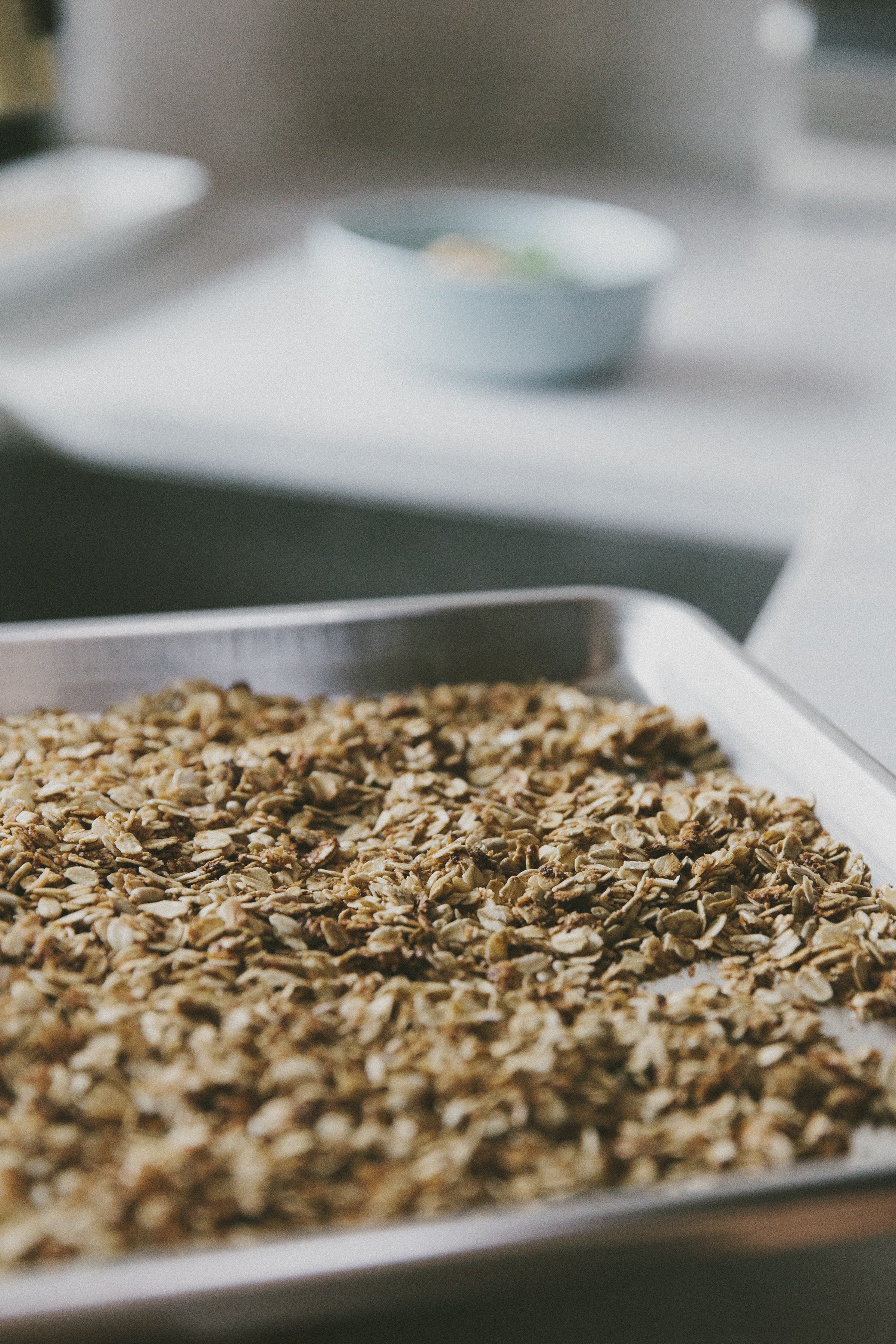
The Bowl
New Norm Bowl, Menu Design, Denmark
The Danish design firm Norm created the New Norm bowl for Menu, inspired by Nordic nature. The bowls are characterized by their purity and simplicity, their design is quiet, unobtrusive. Since the New Norm bowls are available in different colors and sizes, they mix with each other vividly.
